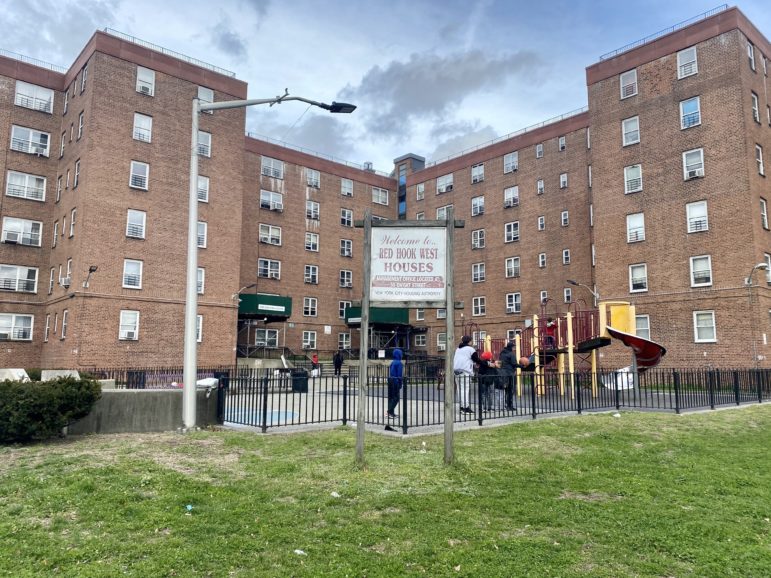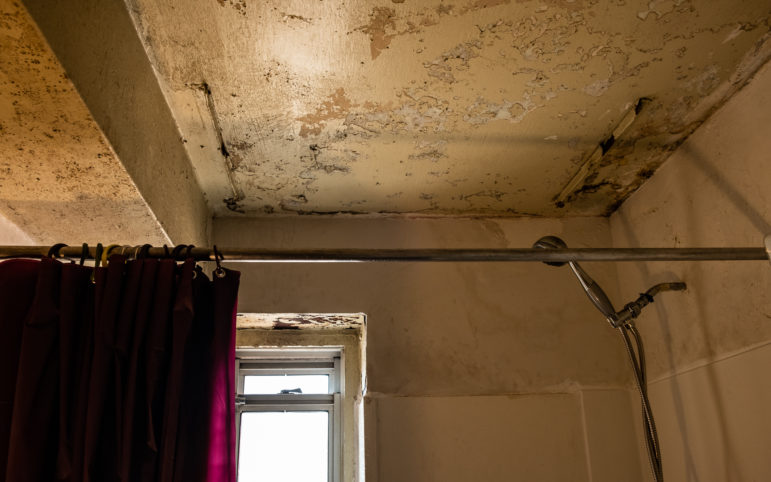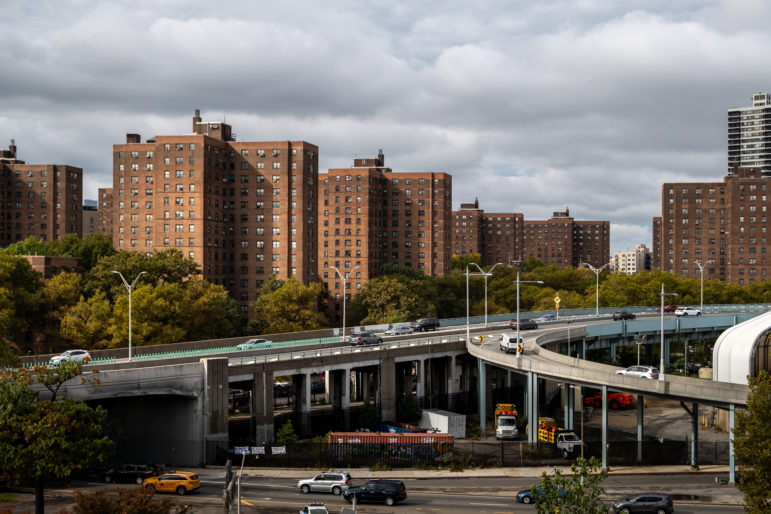The length of time it takes NYCHA to rent out available apartments has climbed in recent years, one of many factors exacerbating the city’s affordable housing crisis, lawmakers say. “They just say it’s not ready,” said one resident currently living in a homeless shelter who has been waiting more than 10 months to move into the NYCHA unit she was approved for.

Sadef Ali Kully
The Red Hook Houses West, the largest NYCHA development in Brooklyn. More then 100 apartments there were vacant in January 2023.
In March of last year, Naomi Sierra was told she’d been selected for an apartment at the Butler Houses, a NYCHA campus in The Bronx. It was welcomed news for Sierra, who had been staying in a city homeless shelter in Brooklyn with her two children since early 2021.
“It would be really convenient for me to move out here because I already know everything in this area,” Sierra said of the NYCHA apartment, which is close to where her mother lives and has more affordable daycare options than the neighborhood her shelter is in. “They told me that they had to fix up the apartment, and that could take up to six to eight weeks. So I wasn’t expecting a long wait.”
But wait she did—for more than 10 months. At the end of January, Sierra was still waiting for an update on that NYCHA apartment, and had yet to even see the unit in person. “They just say it’s not ready,” she said. “They’re very vague with the updates, which makes it harder to wait. I just want some sort of communication, at the very least.”
The length of time it takes NYCHA to rent out available apartments has climbed in recent years, one of many factors exacerbating the city’s affordable housing crisis, lawmakers charged at a recent City Council hearing. The average amount of time it took NYCHA to turn vacant apartments around for re-occupancy more than doubled last year alone, from 182 days at the start of 2022 to 399 days in January 2023. NYCHA’s “target” for turnaround time is 30 days.
There were nearly 6,000 empty units across NYCHA as of Jan. 16, public housing officials testified to councilmembers. Those vacancies included 1,662 apartments already promised to tenants like Sierra who are still waiting to move in, as well as 992 units that are “temporarily” off the rent rolls because they’re undergoing major fixes, such as lead or asbestos abatement (another 1,000 units are off the rent rolls permanently because they’re used as community spaces or offices, officials said).
Over the course of Mayor Eric Adams’ first year in office, the number of vacant NYCHA units actively on the rent rolls and not already matched to a waitlisted tenant jumped from fewer than 500 at the start of 2022 to 3,410 last month, public data shows.
“Why do we have so many vacancies in our development? It’s unheard of. When I looked at the numbers, I couldn’t believe it,” said Dana Elden, president of the resident council at the St. Mary’s Park Houses in The Bronx, where vacancies jumped from 36 to 59 apartments in the last year.
City Councilmember Lincoln Restler, whose north Brooklyn district is home to several NYCHA campuses, called the jump in vacancies and turnaround delays “profoundly troubling.” He pointed to Mayor Adams’ recent decision to slash vacant staff positions at city agencies, as the administration simultaneously struggles to shelter its growing homeless population.
READ MORE: Tensions Over Conditions at Emergency Shelters as NYC Struggles to House Migrants
“Our inability to staff NYCHA is hurting families that need housing,” Restler said, saying those vacant homes should be made available to tenants like Sierra stuck waiting in city shelters, where more than 70,000 New Yorkers slept Thursday night.

Adi Talwar
Water damage in an apartment bathroom at NYCHA’s Red Hook West. More then 100 units in Red Hook West were vacant in January 2023.
New lead standards and costly repairs
The increase in vacancies comes as the cash-strapped housing authority attempts to to collect rent from tenants who fell behind on payments during COVID-19. More than 73,000 NYCHA households owed approximately $454 million in rent arrears at the end of 2022, with public housing unlikely to receive help from the state’s pandemic rent relief program, which prioritized private market tenants for the limited funding.
NYCHA officials have said the rent shortfall is jeopardizing its ability to tackle an estimated $40 billion in needed capital repairs across the system, where buildings are plagued by mold, malfunctioning elevators and unreliable heat. There were more than 679,000 open work orders for repairs across NYCHA last month, a number that’s increased over the last year, as has the length of time it takes for NYCHA to complete repairs.
Repair work on empty apartments “competes with work in occupied units,” for NYCHA staffing and resources, NYCHA Chief Operating Officer Eva Trimble said during the City Council hearing.
“We are working as fast as we can with the resources that we have,” she said, saying they’re currently rehabbing between 150 and 200 vacant units a month for new occupancy.
The process was complicated last year by legislation that lowered the city’s allowable threshold for lead in paint, meaning more apartments will now require abatement work under the law. NYCHA tests for lead when an apartment changes tenants, and the testing process alone takes four to six months, Trimble testified. If an apartment tests above the allowable threshold, it needs another two and a half months of abatement work, she added.
Officials said it costs the city between $28,000 to $63,000 per apartment to complete lead and asbestos testing, and if needed, remediation work. In January, there were nearly 1,000 units at NYCHA awaiting that kind of major work, and those apartments were vacant for an average of 537 days.
Even apartments that don’t need remediation are likely to need other upgrades, Trimble said, as NYCHA residents live in their units for an average of 25 years. “The apartments still need significant general repairs,” she said. Overall in 2022, it took an average of 236 days for NYCHA to get an apartment ready, including those that needed lead and asbestos work. The average cost of repairing a vacant unit for re-occpancy was $45,000.
“Along with staff and funding constraints, it means that we are not turning over apartments as quickly as we would like,” Trimble testified. “However, I am proud to be able to say that anyone moving into a NYCHA apartment will be safe from lead and asbestos.”
That $45,000 is still less than what it costs to keep a family in shelter for a year, several lawmakers pointed out. “I’d rather fix up the apartments and provide permanent housing,” Restler said.
Tenants in limbo
More than 278,000 people were on the waitlist for a NYCHA apartment in December, city data shows. Certain applicants are given priority for available units, including homeless New Yorkers referred by certain city agencies, victims of domestic violence and crime witnesses.
That means delays in readying vacant apartments can leave vulnerable residents languishing in bad situations for months, councilmembers and advocates testified, particularly tenants requesting a transfer from one NYCHA unit to another. This can include residents looking to move for safety or health reasons, like a conflict with a neighbor, or mold infestation that exacerbates their asthma.

Adi Talwar
A view of NYCHA’s Wagner Houses in East Harlem from the Robert F. Kennedy Bridge. There were more than 80 vacant units at the complex last month, city data shows.
“Residents are waiting far too long for their transfers,” Trimble acknowledged. “And many of them are in dire needs, whether it’s domestic violence or health related issues or other situations.”
Ramona Campbell, a NYCHA resident in Brooklyn, told City Limits her request to be transferred to a NYCHA campus in Queens was approved more than a year ago, in September 2021— a request she made because of an ongoing conflict with neighbors that has left her feeling unsafe in her current location.
“I have about 60 police reports based upon the incidents between me and them [the neighbors], and they [NYCHA] still have not moved me,” she said, saying it’s been hard to get answers about the status of her case, despite visits to NYCHA offices and repeated requests for information.
“I’m left stuck in the same position,” she said. “At this point, I am ready to go anywhere. I just want to get out.”
Alexandra Dougherty, a senior staff attorney at Brooklyn Defender Services, says delays for NYCHA apartments have been particularly harmful for her clients with children in the city’s foster care system.
“We see both the stabilizing effect that NYCHA housing can have for our clients by providing one of the only truly permanent affordable housing options in the city, as well as the challenges our clients face attempting to access public housing,” she testified at the Council’s oversight hearing.
She shared the story of one mother for whom stable housing was a requirement to gaining back custody of her kids. The client was approved for a NYCHA apartment, but had to wait 10 months before she could move into the unit, Dougherty said—during which time she remained separated from her kids.
“Children in New York City’s foster system remain in placements on average for two years, which is six months longer than children outside of the city. In our experience, a lack of stable housing contributes to these long stays,” Dougherty said.
NYCHA officials said they are no longer matching tenants with units until apartments are move-in ready, as opposed to notifying them when the unit is first vacated and before repairs are done, setting them up for potentially long wait times.
Of course, that won’t speed up the construction work itself. The city allocated $78 million in the current fiscal year for what it calls the Vacant Readiness Program, which NYCHA uses to hire vendors to make repairs at empty units, officials said. But as part of a citywide cost-savings initiative last fall, Mayor Adams cut the program’s budget by nearly $31 million over the next four years.
Trimble told lawmakers that shouldn’t impact NYCHA’s ability to hit its goal of readying 2,200 vacant units for new tenants this current fiscal year, which ends in June. But lawmakers seemed skeptical. “I feel like I’m hearing you say, ‘We’re going to try our best, we don’t know,’ without saying, ‘A cut in funding means cutting vendors—means cutting service delivery,'” said Councilmember Alexa Avilés, who chairs the public housing committee.
Avilés plans to push for “full restoration” of funding for the Vacant Readiness program, she added, and indicated it would be a point of contention in budget negotiations over the next few months. The Council will begin hearings soon on the mayor’s preliminary spending plan for fiscal year 2024, which progressive members have already decried for cutting social service programs.
“The mayor’s call to house New Yorkers is in direct contrast to what he’s laid out in the preliminary budget,” Avilés said.









5 thoughts on “Wait Times for NYCHA Apartments Doubled Last Year, As Number of Vacant Units Climb”
Before budget cutbacks are reversed and extra money is spent, taxpayers deserve to know if inflation adjusted dollars are going as far towards repair and turnarounds as they used to. Is the money – which is considerable under any measure – being well-spent?
NYCHA is going from crisis to complete catastrophic breakdown in slow motion, but the situation will reach a death spiral, if it hasn’t already, where apartments are failing faster than they can be fixed, leading to insurmountable building-wide problems and not enough paying tenants to fund a comeback. Maybe NYCHA is there already.
Always excuses for NYCHA….I worked in the subsidized housing field in management for 30 years, as an Exec Dir with two for over 18 years, turn around times of over a year? Come on I don’t care what the reasons are, they can do better. Simple logic and math, if they are having such financial difficulties, get new people leased first….and NYCHA always got the most money and operated poorly, , continually throwing money at problems is not solving the problems!!!, always the whoa is me HA…come on stop making excuses and start performing…..
I feel they need to get better workers and stop with the short staff. They have all these money to fix the outside then the inside. They want to rise the rent for people who doesn’t work don’t even get enough income. Even when they have program for low income the rent still high. They need to do better for us.
Well my daughter Leisha Roman and her son has been waiting for 10 yrs and 2 yrs for an interview for a NYCHA Apt and she is without a perminant resident.. floating here and there I til she gets called..It’s ridiculous to have to wait so long..
Well my daughter Leisha Roman and her son has been waiting for 10 yrs and 2 yrs for an interview for a NYCHA Apt and she is without a permanently resident.. floating here and there I til she gets called..It’s ridiculous to have to wait so long..